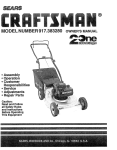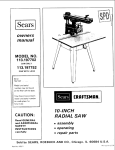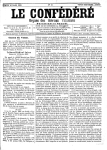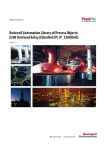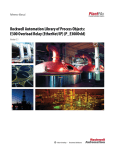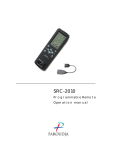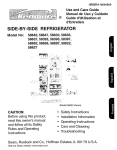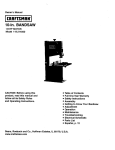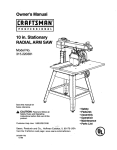Download Craftsman 172.21299 Operator`s manual
Transcript
Operator's Manual lO-in. Table Saw Double Insulated Model No. 172.21299 Save this manual for future reference. CAUTION: Read, understand and follow all Safety Rules and Operating Instructions in this manual before using this product. Sears, Roebuck and Co., Hoffman Estates, IL 60179 U.S.A. , SAFETY • FEATURES ° ADJUSTMENT ° OPERATION • MAINTENANCE Warranty. ........................................................................................ Page 2 Safety Instructions ....................................................................... Pages 3 - 11 Safety Symbols ........................................................................ Pages 3 and 6 Glossary Pages 12-13 Unpacking ....................................................................................... Page 14 Tools Needed ................................................................................. Page 15 Description ..................................................................................... Assembly ........................................................................................ Page Pages 16 17-19 Adjustments ................................................................................... Pages 19-23 Operation ................................................................................... Maintenance .................................................................................. Pages Pages 23-27 28-29 Accessories ................................................................................... Page 29 of Terms .................................................................... ONE YEAR FULL WARRANTY ON COMPANION TOOL If this Companion tool fails due to a defect in material or workmanship within one year from the date of purchase, CONTACT THE NEAREST SEARS PARTS & REPAIR CENTER at 1-800-4-MY-HOME ®and Sears will replace it, free of charge. This warranty applies only while this product is in the United States. This warranty is void if this tool is used for commercial This warranty gives you specific from state to state. Sears, Roebuck or rental purposes. legal rights, and you may also have other rights which vary q__,l Co., 3ept. 817WA, Hoffman Estates, SAVE THESE INSTRUCTIONS! READ ALL INSTRUCTIONS! 2 IL 60179 ii ii / WARNING: BE SURE to read and understand all safety instructions in this manual, including all safety alert symbols such as DANGER, WARNING and CAUTION, BEFORE using this saw. Failure to follow all instructions listed below may result in electric shock, fire and/or serious personal injury. t t ilt SAFETY SYMBOLS The purpose of safety symbols is to attract your attention to possible dangers. The safety symbols, and the explanations with them, deserve your careful attention and understanding. The safety warnings DO NOT by themselves eliminate any danger. The instructions and warnings they give are no substitutes for proper accident prevention measures. SYMBOL MEANING /_ SAFETY ALERT SYMBOL: Indicates danger, warning or caution. May be used in conjunction with other symbols or pictographs. DANGER: Failure to obey a safety warning will result in serious injury to yourself or to others. Always follow the safety precautions to reduce the rip,i: of fire, electric shock and personal injury. WARNING: Failure to obey a safety warning can result in _::,Jious i_!juiy to yourself or to others. Always follow the safety precautions to reduce the risk of fire, electric shock and personal injury. CAUTION: Failure to obey a safety warning may result in property damage or personal injury to yourself or to others. Always follow the safety precautions to reduce the risk of fire, electric shock and personal injury. NOTE: Advises you of information maintenance of the equipment. or instructions i WEAR YOUR vital to the operation or r i!k, WARNING: The operation of any saw can result in foreign objects being thrown into your eyes, which can result in severe eye damage. Before beginning power tool operation, ALWAYS wear safety goggles or safety glasses with side shields and a full face shield when needed. We recommend A Wide Vision Safety Mask for use over eyeglasses or standard safety glasses with side shield, both available at Sears Retail Stores. ALWAYS wear eye protection which is marked to comply with ANSI Z87.1. _ t i t ELECTRICAL SAFETY GENERAL ELECTRICAL ii CONNECTIONS i ii i ii /!k DANGER: To reduce the risk of electrocution: 1. Use only identical replacement parts when servicing. Servicing should be performed by a qualified service technician. 2. Do not use in rain or where floor is wet. This tool is intended for indoor use only. I II II 110-120-Volt, 60 Hz. Tool Information The plug supplied on your tool may not fit into the outlet you are planning to use. Your local electrical code may require slightly different power cord plug connections. If these differences exist refer to and make the proper adjustments per your local code before your tool is plugged in and turned on. In the event of a malfunction or breakdown, grounding provides a path of least resistance for electric current to reduce the risk of electric shock. This tool is equipped with an electric cord having an equipment-grounding conductor and a grounding plug, as shown in Figure A. The plug must be plugged into a matching outlet that is properly installed and grounded in accordance with all local codes and ordinances. Do not modify the plug provided. If it will not fit the outlet, have the proper outlet installed by a qualified electrician. A temporary adapter may be used to connect this plug to a 2-prong outlet (as shown in Figure A), if a properly grounded 3-prong outlet is not available. This temporary adapter should be used only until a properly grounded 3-prong outlet can be installed by a qualified electrician. The green colored rigid ear, lug or the like, extending from the adapter must be connected to a permanent ground, such as a properly grounded outlet box. Improper connection of the equipment-grounding conductor can result in a risk of electric shock. The condvdor with insulation having an outer surface that is green with or without yellow stripes i_ ihc _quipment-grounding conductor. If repair or replacement of the electric cord or plug is ,,_xx_ssa:"_,b not connect the equipment-grounding conductor to a live terminal. I installing or removing the permit plug tofingers or fromtothe outlet. WARNIN( : _o not touch the terminals of plug when If the grounding instructions are not completely understood, or if you are in doubt as to whether the tool is properly grounded, check with a qualified electrician or service personnel. i i i, /ik WARNING: i u If not properly grounded, this tool can cause an electrical shock, particularly when used in damp locations, in proximity to plumbing, or out of doors. If an electrical shock occurs there is the potential of a secondary hazard, such as your hands contacting the saw blade. 4 GENERAL ELECTRICAL CONNECTIONS cont. ii i Fig. A 3-Prong Plug Properly Grounded 3-Prong Outlet NOTE: The adapter illustrated is for use only if you already have a properly grounded 2-prong outlet. NOTE: In Canada, the use of a temporary adapter is not permitted by the Canadian Electrical Code Grounding(_ -1 Lu(. 3-Prong Plug J__'(_dapter j Make sure this is Connected to a Known Ground 2-Prong Plug 1. If operating the power tool in damp locations is unavoidable, ALWAYS use a Ground Fault Circuit Interrupter to supply power to your tool. ALWAYS wear electrician's rubber gloves and footwear in damp conditions. 2. DO NOT expose power tools to rain or wet conditions. Water entering a power tool will increase the risk of electric shock. 3. ALWAYS periodically inspect tool cords and extension cords for damage. Have damaged cords repaired at a Sears Service Center. BE SURE to stay constantly aware of the cord location and keep it well away from the moving blade. 4. ALWAYS use the proper extension cord and MAKE SURE the cord is in good condition. ONLY USE a cord that is heavy enough to carry the current your tool will draw. An undersized cord will cause a current drop in line voltage resulting in a loss of power and overheating. A wire gauge size AWG (American Wire Gauge) of at least 14 is recommended for an extension cord 25 feet or less in length. If in doubt, use the next heavier size. Smaller gauge wires, have greater capacity (14 gauge wire has more capacity than 16 gauge wire). 5. DO NOT abuse the cord. NEVER use the cord to pull the plug from the outlet. Keep cord away from heat, oil, sharp edges or moving parts. Replace damaged cords immediately. Damaged cords increase the risk of electric shock. 6. When operating a power tool outside, ALWAYS use an outdoor extension cord marked "W-A" or "W". These cords are rated for outdoor use and reduce the risk of electric shock. 5 Some of the following symbols may be used on this tool. Please study them and learn their meaning. Proper interpretation of these symbols will allow you to operate the tool better and safer. SYMBOL NAME Wet Conditions Alert i DESIGNATION / EXPLANATION Do not expose to rain or use in wet conditions. i iin Read The Operator's Manual To reduce the risk of injury, user must read and understand operator's manual before using this product. Eye Protection Always wear safety goggles or safety glasses with side shields and a full face shield when operating this product. i ! Safety Alert Precautions that involve your safety. No Hands Symbol Failure to keep your hands away from the blade will result in serious personal injury. No Hands Symbol Failure to keep your hands away from the blade will result in serious personal injury. No Hc_,_.:oSymbol Failure to keep your hands away from the blade will result in serious personal injury. No Hands Symbol Failure to keep your hands away from the blade will result in serious personal injury. Hot Surface To reduce the risk of injury or damage, avoid contact with any hot surface. 6 WORK AREA SAFETY 1. ALWAYS keep your work area clean and well lit. DO NOT leave tools or pieces of wood on the saw while it is in operation. Cluttered benches and dark areas invite accidents. 2. DO NOT operate power tools in explosive atmospheres, such as in the presence of flammable liquids, gases, or dust. Power tools create sparks which may ignite the dust or fumes. 3. ALWAYS keep bystanders, children and visitors away while operating a power tool. Distractions can cause you to lose control. 4. ALWAYS make your workshop childproof with padlocks and master switches or by removing starter keys. 5. ALWAYS make sure the work area has ample lighting so you can see the work and that there are no obstructions that will interfere with safe operation BEFORE using your saw. PERSONAL SAFETY 1. ALWAYS know your power tool. Read the operator's manual carefully, learn the saw's applications and limitations, as well as, the specific potential hazards related to this tool. 2. ALWAYS stay alert, watch what you are doing and use common sense when operating a power tool. DO NOT use tool while tired or under the influence of drugs, alcohol or medication. A moment of inattention while operating power tools may result in serious personal injury. 3. ALWAYS dress properly. DO NOT wear loose clothing, gloves, neckties, rings, bracelets or other jewelry that can get caught and draw you into moving parts. Non-slip footwear is also recommended. Pull back long hair. Keep your hair, clothing and gloves away from moving parts. Loose clothing, jewelry or long hair can be caught in moving parts. 4. ALWAYS remove adjusting keys or wrenches before turning the tool on. A wrench or a key that is left attached to a rotating part of the tool may result in personal injury. 5. ALWAYS wear safety glasses with side shields. Everyday eyeglasses have only impact resistant lenses, they are NOT safety glasses. 6. ALWAYS wear a dust mask to keep you from inhaling fine particles. 7. ALWAYS protect your hearing. Wear hearing protection during extended periods of operation. 8. ALWAYS secure your work. Use clamps or a vise to hold work when practical. It is safer than using your hand and frees both hands to operate tool. 9. DO NOT overreach. ALWAYS keep proper footing and balance at all times. Proper footing and balance enables better control of the tool in unexpected situations. 10. ALWAYS avoid accidental starting. BE SURE switch is in the "Off" position before plugging in. 11. NEVER stand on tool. Serious injury could occur if the tool is tipped or if the blade is accidentally contacted. 7 TOOL USE AND CARE SAFETY 1. NEVER leave the tool running unattended. ALWAYS turn it off. DO NOT leave the tool until it comes to a complete stop. 2. DO NOT use the tool if the switch does not turn it "On" or "Off". Any tool that cannot be controlled with the switch is dangerous. ALWAYS have defective switches replaced at a Sears Service Center. 3. ALWAYS disconnect the plug from the power source before making any adjustments, changing accessories or storing the tool. Such preventive safety measures reduce the risk of starting the tool accidentally. 4. ALWAYS store idle tools out of the reach of children and other untrained persons. Tools are dangerous in the hands of untrained users. 5. ALWAYS maintain tools with care. Keep cutting tools sharp and clean. Properly maintained tools with sharp cutting edges are less likely to bind and are easier to control. Follow instructions for lubricating and changing accessories. 6. DO NOT force the tool, it will do the job better and moresafely at the rate for which it was designed. 7. ALWAYS use the right tool for the job. DO NOT force the tool or attachment to do a job it was not designed for. Use it only the way it was intended. 8. Before using this saw, ALWAYS check for damaged parts, including guards for proper operation and performance. Also ALWAYS check the alignment of moving parts, binding of moving parts, breakage of parts, saw stability, mounting and any other condition that may affect the tool's operation. If damaged, have the tool serviced at a Sears Service Center before using. Many accidents are caused by poorly maintained tools. I /ik WARNING: USE OF ACCESSORIES THAT ARE NOT RECOMMENDED USE WITH THIS TOOL MAY CREATE A HAZARDOUS CONDITION. 9. ALWAYS use only accessories that are recommended for this tool. Using improper accessories may cause the risk of serious injury. 8 FOR ADDITIONAL SPECIFIC SAFETY RULES FOR TABLE SAWS 1. ALWAYS USE SAW BLADE GUARD, splitter and anti-kick-back pawls for every operation for which they can be used, including through sawing. Through sawing operations are those in which the blade cuts completely through the workpiece when ripping or cross-cutting. 2. ALWAYS HOLD WORK FIRMLY against the miter gauge or rip fence. 3. USE A PUSH STICK when required. Always use a push stick when ripping narrow stock. Refer to ripping instructions in this Operator's Manual where the push stick is covered in detail. 4. NEVER PERFORM ANY OPERATION "FREE HAND", which means using only your hands to support or guide the workpiece. Always use either the fence or miter gauge to position and guide the work. i DANGER: FREE HAND CUTTING IS A MAJOR CAUSE OF KICK-BACK AND FINGER/HAND AMPUTATIONS. I 5. NEVER STAND or have any part of your body in line with the path of the saw blade. Keep your hands out of the saw blade path. 6. NEVER REACH behind or over the cutting tool for any reason. 7. 8. 9. 10. 11. NEVER use a rip fence when cross cutting. DO NOT USE a molding head with this saw. FEED WORK INTO THE BLADE against the direction of rotation only. NEVER use the rip fence as a cut-off gauge when cross-cutting. NEVER ATTEMPTTO FREE A STALLED SAW BLADE without first turning the saw OFF. Turn power switch OFF and disconnect the plug from the power source immediately to prevent motor damage and before removing material. 12. PROVIDE ADEQUATE SUPPORT to the rear and the sides of the saw table for long or wide workpieces. 13. AVOID KICKBACKS (work thrown back towards you) by keeping the blade sharp, the rip fence parallel to the saw blade and by keeping the splitter, anti-kickback pawls and guards in place and functioning. Do not release the the work before it has passed all the way past the saw blade and off the table. Do not rip work that is twisted, warped or does not have a straight edge to guide it along the fence. 14. AVOID AWKWARD OPERATIONS and hand positions where a sudden slip could cause your hand to move into the saw blade. 15. NEVER USE SOLVENTS to clean plastic parts. Solvents could possibly dissolve or otherwise damage the material. Only a soft damp cloth should be used to clean plastic parts. 16. MOUNT your table saw on a bench or stand before performing any cutting operations. Refer to ASSEMBLY on page 17. 17. NEVER CUT METALS or materials which may make hazardous dust. 9 ADDITIONAL SPECIFIC SAFETY RULES FOR TABLE SAWS cont. i I AND FINGER/HAND _, DANGER : FREE i AMPUTATIONS HAND CUTTING i cont.. IS A MAJOR CAUSE OF KICKmBACK I 18. ALWAYS USE IN A WELL-VENTILATED AREA. Remove sawdust frequently. Glean out sawdust from the interior of the saw to prevent potential fire hazard. 19. NEVER LEAVETHE SAW RUNNING UNATTENDED. DO NOT leave the saw until it comes to a complete stop. 20. FOR PROPER OPERATION follow the instructions in this Operator's Manual. Failure to provide sawdust fall-through removal hole will allow sawdust to build up in the motor area resulting in a fire hazard and potential motor damage (see page 17 for details). 21. DO NOT ALLOW ANY UNAUTHORIZED USE OF THIS SAW. Anyone using this saw must first read and completely understand all instructions in this Operator's Manual. 22.THE REAR OFTHETABLE INSERT MUST BE FLUSH TOTHETABLE during all sawing operations. Two different inserts are provided for regular through-sawing operations and dado cutting where a rubber adjusting spacer is provided under the rear of the insert for this purpose. 23. DO NOT USE A DADO BLADE LARGER THAN 6-INCH DIAMETER AND 1/2-INCH WIDTH. WARNING: Some dust particles created by power sanding, sawing, grinding, drilling and other construction jobs contain chemicals known to cause cancer, birth defects or other reproductive harm. Some examples of these chemicals are: • Lead from lead-based paints. • Crystalline silica from bricks and cement and other masonry products. • Arsenic and chromium from chemically-treated lumber. Your risk from these exposures varies, depending upon how often you do this type of work. To reduce your exposure to these chemicals: • Work in a well-ventilated area. • Work with approved safety equipment, such as those dust masks that are specially designed to filter out microscopic particles. 10 ADDITIONAL SPECIFIC SAFETY RULES FOR TABLE SAWS cont. i iii ii /ik WARNING: The operation of any saw can result in foreign objects being thrown into your eyes, which can result in severe eye damage. Before beginning power tool operation, ALWAYS wear safety goggles or safety glasses with side shields and a full face shield when needed. We recommend a Wide Vision Safety Mask for use over eyeglasses or standard safety glasses with side shield, both available at Sears Retail Stores. III SERVICE I SAFETY 1. If any part of this table saw is missing or should break, bend, or fail in any way; or should any electrical component fail to perform properly: ALWAYS shut off the power switch and remove the table saw plug from the power source and have the missing, damaged or failed parts replaced BEFORE resuming operation. 2. Tool service must be performed only at a Sears Service Center. Service or maintenance performed by unqualified personnel could result in a risk of injury. 3. When servicing a tool, ALWAYS use only identical replacement parts. Follow instructions in the Maintenance Section of this manual. Use of unauthorized parts or failure to follow Maintenance Instructions may create a risk of electric shock or injury. The label on your tool may include the following symbols. V........................................................................................... A ........................................................................................... Hz ......................................................................................... W .......................................................................................... rain ....................................................................................... ........................................................................................ ......................................................................................... no ........................................................................................ [] .......................................................................................... .../min ................................................................................... z_ ......................................................................................... IMPORTANT! READ ALL INSTRUCTIONS 11 Volts Amperes Hertz Watts Minutes Alternating current Direct current No-load speed Class II construction Revolutions or reciprocation per minute Indicates danger, warning caution. It means attention!!! Your safety is involved. Arbor The shaft on which a blade or cutting tool is mounted. Revolutions Per Minute (RPM) The number of turns completed by a spinning object in one minute. FPM or SPM Feet per minute (or strokes per minute), used in reference to blade movement. No Hands Zone The area between the marked lines on the left and right side of the miter table base. This zone is identified by no hands zone labels placed inside the marked lines on the miter table base. Throat Plate A plastic throat plate inserted in the miter table that allows for blade clearance. Saw Blade Path The area over, under, behind, or in front of the blade, as it applies to the workpiece. That area which will be or has been cut by the blade. Set The distance that the saw blade tooth is bent (or set) outward from the face of the blade. Miter Cut A cutting operation made with the blade at any angle other than 90 ° to the fence. Compound Miter Cut A compound miter cut is a cut made using a miter angle and a bevel angle at the same time. Cross Cut A cutting or shaping operation made against the grain of the workpiece. Bevel Cut A cutting operation made with the blade at any angle other than 90 ° to the miter table. Dado Cut A non-through cut which produces a square-sided notch or trough in the workpiece (requires special blade). Chamfer A cut removing a wedge from a block of wood so the end (or part of the end) is angled at other than 90 °. Ripping or Rip Cut A cutting operation along the length of the workpiece. Freehand Performing a cut without using a fence, miter gauge, fixture, work clamp, or other proper device to keep the workpiece from twisting or moving during the cut. Through Sawing Any cutting operation where the blade extends completely through the thickness of the workpiece. 12 Non-Through Cuts Any cutting operation where the blade does not extend completely through the thickness of the workpiece. " Resaw A cutting operation to reduce the thickness of the workpiece to make thinner pieces. Heel Alignment of blade to fence. Leading End The end of the workpiece pushed into tool first. Kerf The material removed by the blade in a thorough cut or the slot produced by the blade in a non-through or partial cut. Kickback A hazard that can occur when the blade binds or stalls, throwing the workpiece back toward operator. Throw-Back Throwing of a workpiece in a manner similar to a kickback. Usually associated with a cause other than the kerf closing, such as a workpiece not being against the fence, being dropped into the blade., or being placed inadvertently in contact with the blade. Splitter • A metal piece slightly thinner that the saw blade, which helps keep the kerf open and also helps prevent kickback. Featherboard A device used to help control the workpiece by guiding it securely against the table or fence during any ripping operation. Push Blocks and Push Sticks Devices used to feed the workpiece through the saw blade during cutting operations. A push stick (not a push block) should be used for narrow ripping operations. These aids help keep the operator's hands well away from the blade. Workpiece or Material The item on which the cutting operation is being done. The surfaces of a workpiece are commonly referred to as faces, ends and edges. Work Table The surface where the workpiece rests while performing a cutting, drilling, planing or sanding operation. Gum A sticky, sap-based residue from wood products. Resin A sticky, sap-based substance that has hardened. 13 1. Remove all packing materials from around your saw. 2. Carefully lift the saw from carton and place it on a level work surface. The saw is heavy, so get help, if you need it, to help avoid injuring your back. 3. Do not discard the packing materials until you have carefully inspected the saw for loose or damaged parts and successfully operated the saw. 4. Carefully inspect all parts of the saw to make sure that no breakage or damage has occurred during shipping. ii i WARNING: partsare If any parts are missing, DO NOT operate this tool until the missing replaced. Failure to do so could result in possible serious injury. I The follows items are included with your table saw Fig. 1 A A. Table Saw Assembly B. Blade Guard and Splitter C. Rip Fence, Handle and Screw D. Hand Wheel Handle and Screw E Miter Gauge F. 2 Blade Wrenches G. Push Stick B E C D G I mightWARNING: be dangerous The anduse could 1,4 of cause seriousorpersonal injury. attachments accessories that are not recommended 14 I The following tools are not included, but are needed for removing the blade and for making adjustments on your saw. Fig. 2 lOmm Socket Phillips Screwdriver Ratchet Straight Edge Adjustable Wrench Combination Closed-end Wrench (included) Square Open-end Wrench (included) NOTE: To make assembly easier, keep contents of carton together. Apply a coat of automobile wax to the table. Wipe all parts thoroughly with a clean, dry cloth. This will reduce friction when pushing the workpiece. 15 Your table saw has many built-in convenience features for fast, efficient cutting. Before attempting to use your saw, familiarize yourself with all of the operating features and safety requirements. (See Fig. 3) /_ WARNING: DO NOT allow familiarity with your saw to make you careless. Remember that a careless fraction of a second is sufficient to inflict serious injury. Fig. 3 Anti-Kickback Pawls Blade Guard Blade S_ Splitter Rip Fence Bracket Table Miter Gauge Blade Bevel Lock Knob Blade Tilt Pointer Blade Tilt Scale On/Off Switch with key Blade Tilting and Blade Elevation Hand Wheel Input 13 amps Rating 120 volts, 60 Hz AC No-Load Speed 4500 RPM Blade Diameter 10 in. Cutting Depth at 45° 21/2 in. Cutting Depth at 90 ° 3 in. Table Size 16 x 26 in. 16 MOUNTING SAW TO WORK SURFACE (See Figure 4) I I I I II III I I WARNING: ALWAYS make sure your table saw is securely mounted to a workbench or an approved work stand. Failure to do so could result in an accident, resulting in possible serious personal injury. i i i i i ] DANGER: may cause DO NOT operate this tool on the floor. This is very dangerous serious injury. 1. This saw must be properly and securely mounted to a sturdy work surface using the 4 mounting holes at the base of the saw. 2. The surface of the work surface where the saw will be mounted should have a hole large enough to facilitate sawdust fall-through and removal. 3. Square the saw on the work surface and mark the location of the four mounting holes.. 4. Drill a 3/8-in. hole into each of the 4 mounting hole locations marked on the mounting surface. 5. Mark an 11-inch square centered between the 4 mounting holes. 6. Cut out and remove the square. 7. This opening will allow sawdust to fall through the saw base. and Fig. 4 Square Cutout 8. Place the saw on the work surface, and align the holes on the saw with those drilled through the surface 9. Securely mount the saw to the work surface. ATTACHING ELEVATING THE HANDLE TO BLADE WHEEL (See Figure 5) 1. Place handle bolt into hole on handle and tighten securely. 17 MOUNTING THE RIP FENCE (See Figure 6) 1. Mount the fence handle into the hole and tighten screw. 2. Raise fence handle up so the rear holding clamp is fully extended. 3. Place rip fence on table at desired location with the handle in front of table and holding clamp in the rear. 4. Push down on handle to lock it in place. TO REPLACE BLADE (See Figs. 7 - 9) DANGER: To avoid serious injury, the table insert MUST BE level with the table. If the table insert is not level with the table, adjust the screw until it is level with the table. To raise the insert, turn the screw counterclockwise. To lower the insert, turn the screw clockwise. NOTE: A rubber adjusting spacer is provided under rear of insert for this purpose. ii /ik WARNING: A 10-inch blade is the maximum blade capacity of your saw. A larger than 10-inch blade will come in contact with the blade guards. Also, NEVER use a blade that is so thick that it prevents the outer blade washer from engaging with the flat side of the spindle. Blades that are too large or too thick can result in an accident causing serious personal injury. 1. Unplug the saw. WARNING: Topreventpersonalinjury, ALWAYS disconnect the plug from power source BEFORE assembling parts, making adjustments or changing blades. 2. Remove the table insert by removing the 2 screws. 3. Raise the blade arbor in Fig. 8 to the maximum height by turning the blade raising hand wheel counterclockwise. 4. Place the open end wrench jaws on the flats of the saw arbor to keep the arbor from turning (Fig. 9) and place the box-end wrench on the arbor and turn counterclockwise. 18 TO REPLACE BLADE (See Figs. 7 - 9) cont. 5. Remove the arbor nut and the outer flange. 6. Install a new blade on the arbor with the blade teeth pointing towards front of saw. 7. Install the flange against the blade and thread the arbor nut as far as possible by hand. Be sure the blade is flush against the inner side of the blade flange. MITER GAUGE ADJUSTMENT 1. Unplug the saw. (See Fig. 10) WARNING: Topreventpersonalinjury, ALWAYS disconnect the plug from power source BEFORE assembling parts, making adjustments or changing blades. 2. Make sure the miter gauge will slide freely through both table grooves. 3. Loosen the lock knob. Set the miter head to 90 °. 4. Adjust the pointer to 90 ° on the miter gauge scale. NOTE: The miter gauge is designed with positive stops every 15° for accuracy. RIP FENCE ADJUSTMENT (See Fig. 11) 1. Unplug the saw. WARNING: power source To prevent personal injury, ALWAYS disconnect the plug from BEFORE assembling parts, making adjustments or changing blades. i 2. The fence is moved by lifting up the locking handle and sliding the fence to the desired location. Pushing down on the handle locks the fence in position. 3. Position the fence on the table and along one edge of the miter gauge grooves. 4. Lock the fence handle. The fence should be parallel with the miter gauge grooves. 19 RIP FENCE ADJUSTMENT (See Fig. 11) cont. 5. If adjustment is needed to make the fence parallel to the groove: • Loosen the two screws and lift up on the handle. • Hold the fence bracket firmly against the front of the saw table. Move the far end of the fence until it is parallel with the miter gauge groove. • Tighten both screws and push the handle to lock. 6. If the fence is loose when the handle is in the downward locked position: • Move the handle upward and turn the adjusting screw clockwise until the rear clamp fits snugly. DO NOT turn the adjusting screw more than 1/4 turn at a time. NOTE: Overtightening the adjusting screw will cause the fence to come out of alignment. i serious /!k WARNING: injury. Failure to properly align the fence can cause "kickback" and NOTE: The rip fence and blade are aligned parallel to the miter gauge groove of the table. RIP FENCE INDICATOR ADJUSTMENT (See Fig. 12) 1. Unplug the saw. WARNING: To prevent personal injury, ALWAYS disconnect the plug from power source BEFORE assembling parts, making adjustments or changing blades. I III 2. The rip fence indicator points to the measurement scale. The scale shows the distance between the fence and the blade. 3. Measure the actual distance with a ruler. If there is a difference between the measurement and the indicator, adjust the indicator 4. Loosen the screw and slide the indicator to the correct measurement on the scale. Tighten the screw and re-measure with a ruler ...... 20 ADJUSTING THE 90 ° AND 45 ° POSITIVE STOPS (See Fig. 13-14) Your saw has positive stops that will quickly position the saw blade at 90 ° to the table. Make adjustments only if necessary. 90 ° STOP 1. Unplug the saw. I I I [ I I I I powerWARNING: source BEFORE assembling parts,injury, making adjustments or changing To prevent personal ALWAYS disconnect the plug blades. from I ii I I I _,,_ 2. Turn blade elevation hand wheel counterclockwise to raise the blade to maximum height. 3. Loosen the blade bevel lock knob and move the blade to the maximum vertical position. Re-tighten lock knob. 4. Place a combination square on the table and against the blade to determine if the blade is 90 ° to the table. 5. If blade is not 90 ° to the table, loosen the 2 set screws located on the collar underneath the table saw with the hex key and loosen the collar. 6. Loosen the bevel lock knob. Move the blade tilting wheel and move the blade until it is 90 ° to the table, 7. Adjust the collar so that it is in contact with the bracket when the blade is 90 ° to the table. 8. Tighten the 2 set screws. 45 ° STOP 1. Unplug the saw. WARNING: power source To prevent personal injury, ALWAYS disconnect the plug from BEFORE assembling parts, making adjustments or changing blades. 2. With the blade in the upright 90 ° position, loosen the bevel lock knob and move the blade to the 45 ° position as far as it will go. 3. Place a combination square on the table to check if the blade is 45 ° to the table. 4. If blade is not 45 ° to the table, loosen the 2 set screws located on the collar underneath the table saw with the hex key and loosen the collar. 5. Re-tighten the bevel lock knob and secure the screw until resistance is felt. 21 BLADE TILT POINTER 1. Unplug the saw. WARNING: To prevent personal injury, ALWAYS disconnect the plug from power source BEFORE assembling parts, making adjustments or changing blades. I 2. When the blade is positioned at 90 °, adjust the blade tilt pointer to read 0° on the scale. 3. Loosen the mounting screw, position the pointer over 0 ° and re-tighten screw. NOTE: Make a trial cut on scrap wood before making the cut you want. Measure for exactness. BLADE PARALLEL TO THE MITER GAUGE GROOVE (See Figure 15) This adjustment was made at the factory, but it should be rechecked and adjusted as necessary. WARNING: This adjustment must be correct or kickback could result in a serious injury and accurate cuts cannot be made. 1. Unplug the saw. /!k WARNING: To prevent personal injury, ALWAYS disconnect the plug from power source BEFORE assembling parts, making adjustments or changing blades. 2. Remove the blade guard for thisprocedure, but it must be re-installed and aligned after this adjustment. 3. Move the blade to the highest position and set at the 0 ° angle (90 ° straight up). 4. Select and mark (with a felt-tip marker) a blade tooth having a "right set" and rotate the blade so the marked tooth is 1/2-inch above the table. Place a combination square base into the right side miter gauge groove. Adjust the ruler so it touches the front marked tooth and then lock the rule so it holds its position in the square assembly. Rotate the blade bringing the marked tooth to the rear and about 1/2-inch above the blade. 8. Carefully slide the combination square to the rear until the ruler touches the marked tooth. w = = = If the ruler touches the marked tooth at the front and rear position, no adjustment is needed at this time. If not or the base of the rule is no longer parallel with the edge of the miter gauge groove follow steps 12-14 on next page, 22 BLADE PARALLEL TO THE MITER GAUGE GROOVE (See Figure 15) cont. 10. Stand at the rear of the saw and gently pry the rear blade alignment rod to the Left or Right with a medium size slotted screwdriver. 11, While moving the rod simultaneously use a framing square to measure the distance at the front and rear of the blade to an edge on the miter slot. When the distances are within 1/64-inch or closer, tighten both re_tr blade alignment straps bolts. NOTE: The blade alignment rod will only move slightly. 12. If it is still not aligned, loosen the two front blade alignment rod strap bolts. 13. Stand at the front of the saw and gently pry the front blade alignment rod to the Left or Right with a medium size slotted screwdriver. 14. While moving the rod simultaneously use a framing square to measure the distance at the front and rear of the blade to an edge on the miter slot. When the distances are within 1/64-inch or closer, tighten both rear blade alignment straps bolts. NOTE: The blade alignment rod will only move slightly. 15. Tighten both middle blade alignment straps bolts. NOTE: Recheck to make sure all six bolts are properly re-tightened and that the distance from the front and rear of the blade and the miter gauge groove are within 1/64-inch from one another. 16. Re-install blade guard and splitter assembly, and adjust the alignment with the blade. TABLE SAW FEATURES ELEVATING HANDLE (FIGURE 16) The elevating handle is used for raising and lowering the blade. Turn the handle clockwise to lower the blade. To raise blade turn handle counterclockwise. TILTING HANDLE (FIGURE 16) The tilting is used to tilt the blade for bevel cutting. 1. Loosen lock knob and move hand wheel to the desired angle. 2. Tighten lock knob to lock in at desired angle. 23 ON / OFF SAFETY SWITCH (FIGURES 17-18) 1. To turn saw ON ,push switch upwards. To turn saw OFF, pull switch down. 2. To lock switch in the OFF position, hold the end of the toggle switch and pull out the safety switch key. 3. With the safety key switch key removed, the switch will not operate. 4. If the switch key is removed while the saw is running, it can be shut OFF, but cannot be re-started until key is reinserted. SPLITTER The splitter separates the saw kerf in the workpiece to help prevent binding and kickback: RIP FENCE The rip fence should be used in all ripping operations. NEVER try to make a free-hand rip cut without the fence in place and locked securely. MITER GAUGE The miter gauge should be used in all mitering and crosscutting operations. ALWAYS lock it securely by tightening the lock handle. BASIC CUTTING OPERATIONS There are two basic types of cuts: ripping and crosscutting. Ripping is cutting along the length and with the grain of the workpiece. Crosscutting is cutting either across the width or across the grain of the workpiece. Neither ripping or crosscutting may be done safely freehand. Ripping requires the use of the rip fence, and crosscutting requires the miter gauge. NEVER use the rip fence and miter gauge at the same time. i i n WARNING: BEFORE using the saw, ALWAYS check the following: A. The blade is tight on the arbor. B. The bevel lock knob is tight. C. When ripping that the fence lock handle is tight and the fence is parallel to the blade. D. The blade guard is in place and working properly. E. You are wearing safety glasses. Failure to adhere these common safety rules, and those at the beginning of this manual, can greatly increase the risk of serious injury. 24 RIPPING (See Figure 19) i WARNING: Topreventserious injury: A. NEVER use the miter gauge when ripping. B. NEVER use more than one rip fence during a single cut. C. DO NOT let familiarity with your saw make you careless in its operation. Remember it only takes a careless fraction of a second to cause severe personal injury. D. ALWAYS keep both hands away from the blade and blade path. E. ALWAYS hold the flat edge of the workpiece against the fence, not the warped edge. i I u i i operation. DANGER: This willNEVER cause kickback attempt to and pullpossible the workpiece serious backwards injury to theduring user. a cutting I HI 1. Securely tighten the rip fence to the table. 2, Raise the blade so it is approximately 1/8-inch above the workpiece. 3. Place the workpiece flat on the table and against the fence. Keep the workpiece about 1-inch away from blade. 4. Turn on the saw and wait for the blade to reach full speed. 5. Slowly feed the workpiece into the blade by pushing forward with the push stick, Only push the workpiece section that will pass between the blade and the fence. /iX workpiece WARNING: ALWAYS AVOID KICKBACK. push forwardon the section of ] the that will pass between the blade andOnly the fence. ALWAYS use a push stick. I I II 6. Continue pushing the workpiece with the push stick until it passes the blade guard and clears the rear of the table, BEVEL RIPPING This cut is the same as a rip cut except the blade bevel scale is set at an angle other than 0 °. WARNING: I blade. I i Cut only with the workpiece and the fence on the right side of the I i i i ii i i i i 25 i i I BASIC CUTTING OPERATIONS cont. CROSSCUTTING 90 ° MITER ANGLE (See Figure 20) ii nl operation. Remember it only takes a careless fraction of a second to cause severe /ik WARNING: DO NOT familiarity in its personal injury. ALWAYS keepletboth hands with awayyour fromsaw themake bladeyou andcareless blade path. i i A DANGER: attempt to pull the workpiece operation. This will NEVER cause kickback and possible serious backwards injury to theduring user. a cutting 1. Place miter gauge in a miter gauge slot on the table. 2. Raise the blade so it is approximately 1/8-inch above the workpiece. 3. Hold the workpiece firmly against the miter gauge with the blade path in line with desired cut location. Keep the workpiece about 1-inch away from blade. 4. Turn on the saw and wait for the blade to reach full speed. 5. NEVER stand directly in line with the saw blade path, ALWAYS stand to the side of the blade. 6. Keep the workpiece flat against the front of the miter gauge and flat against the table. Then slowly push the workpiece through the blade. 7. DO NOT try to pull the workpiece back with the blade turning. Turn the switch off and carefully slide the workpiece out when the blade has stopped turning. i iik WARNING: when crosscutting ALWAYS position the larger surface of the workpiece on the table and/or bevel crosscutting to avoid unstability. 26 ! BEVEL CROSSCUTTING 0 °- 45 ° BLADE BEVEL, 90 ° MITER ,ANGLE (See Figure 21) This operation is the same as crosscutting, except the blade is at a bevel angle other then 0 °. 1. Adjust blade to the desired angle and tighten the blade bevel lock lever 2. Tighten miter lock handle at 90 °. COMPOUND MITER CROSSCUTTING (See Figure 22) 0° - 45 ° BLADE BEVEL, 0° - 45 ° MITER ANGLE This operation combines a miter angle with a bevel angle. i WARNING: ALWAYS work to the left side of the blade during this type of cut. The miter gauge must be in the left side miter groove. 1. Set the miter gauge to the desired angle. Use only the left side groove. 2. Set the blade I::eve; to the desired angle. 3. Carefully push the miter gauge to begin the cutting operation. 27 Fig. 22 III II II I I I I II III key. WARNING: Remove plug from For power your own source safety, before turn maintaining the switch OFF or lubricating and remove yourthesaw. switch I III III I I I GENERAL 1. Clean out all sawdust that has accumulated I I I ] II inside the saw cabinet and the motor. 2. Polish the saw table with an automotive wax to keep it clean and make it easier to slide the workpiece. 3, Clean the cutting blade with pitch and gum remover. 4. Immediately replace the power cord if it is worn, cut or damaged in any way. I III WARNING: All electrical or mechanical repairs should be only be done by a trained service technician. Use only identical replacement parts. Amy other parts may create a hazard. I II I I 5. Use liquid dish washing detergent and water to clean all plastic parts. NOTE: Certain cleaning chemicals can damage plastic parts. 6. Avoid the use of the following cleaning chemicals or solvents: ammonia and household detergents containing ammonia. BLADE RAISING AND TILTING MECHANISM (SEE FIGURE 22) After each 5 full hours of operation, the blade raising mechanism should be checked for looseness, binding, or ether abnormalities. With the saw disconnected from the power source, turn the saw upside down and alternately pull upward and downward on the motor unit. Look for any movement of the motor mounting mechanism. Looseness or play in the blade raising screw should be adjusted as follows: 1. Use a 14mm wrench to loosen the check-nut. . Tighten the adjusting nut until it is finger tight against the bracket, then back off the nut 1/6 of a turn. 3. Tighten the check-nut with the wrench, while holding the adjusting nut in place. The screw rod should only have a maximum allowable play in and out of 1/8 inch. You can place a small amount of dry lubricant on the bevel angle adjustment rod also. This rod must be kept clean and free of sawdust, gum, pitch and other contaminants for smooth operation. If excessive looseness is observed in any parts of the blade raising mechanism or tilting mechanism, take the saw to a Sears Service Center. 28 when using this tool or blowing dust. If operation WARNING: wear safety goggles or safety glasses with side shields is dusty, also wear ALWAYS a dust mask. I I II I I I I I I I I I I LUBRICATION All of the bearings in this tool are lubricated at the factory with a sufficient amount of lubricant. Therefore, no further lubrication is required. On all mechanical parts of your table saw where a pivot or threaded rod are present, lubricate using graphite or silicone. These dry lubricants will not hold sawdust like oil or grease would. Sears offers a large selection of blades, table extensions, roller tables, extension cords and more that are ideal for use with your 10-inch Table Saw for a variety of cutting needs. i i A, WARNING: The use of attachments result in serious personal injury. EXTENSION or accessories not sold by Sears may I CORDS The use of any extension cord will cause some loss of power. To keep the loss at minimum and to prevent overheating, use an extension cord that is heavy enough carry the current that the tool will draw. A wire gauge (AWG) of at least 14 is recommended for an extension cord 25 feet in length. When working outdoors ALWAYS use an extension cord that is suitable outdoor use. The cord's jacket will be marked WA. i J in i i i i ii ii a to or less for i /_ CAUTION: extension cordstools, awayetc. from the cutting area,operation. and position the cord so it will not getKeep caught on lumber, during the cutting i i immediately. Check extension cord before each use. If damaged, replace it NEVER use a tool with a damaged cord because touching the damagec i II I i WARNING: ! ] i i area could cause electrical shock, resulting in serious injury. I 29 ! i I I II NOTES 30 NOTES 31 Get it fixed, at your home or ours! Your Home For repair-in your home-of all major brand appliances, lawn and garden equipment, or heating and cooling systems, no matter who made it, no matter who sold it! For the replacement parts, accessories and owner's manuals that you need to do-it-yourself. For Sears professional installation of home appliances and items like garage door openers and water heaters. 1-800-4-MY-HOME ® (1-800-469-4663) Call anytime, day or night (U.S.A. and Canada) www.sears.com www.sears.ca Our Home For repair of carry-in items like vacuums, lawn equipment, and electronics, call or go on-line for the location of your nearest Sears Parts & Repair Center. 1-800-488-1222 Call anytime, day or night (U.S.A. only) www.sears.com To purchase a protection agreement (U.S.A.) or maintenance agreement (Canada) on a product serviced by Sears: 1-800-827-6655 1-800-361-6665 (U.S.A.) Au Canada pour service en fran_ais: Para pedir servicio de reparaci6n a domicilio, y para ordenar piezas: 1-888-SU-HOGAR (Canada) 1-800-LE-FOYER SM Mc (1-800-533-6937) www.sears.ca (1-888-784-6427) Sesir® Registered Trademark / TMTrademark / SM Service Mark of Sears, Roebuck and Co ® Marca Registrada / TM Marca de Fabrica / SM Marca de Servicio de Sears, Roebuck and Co MC Marque de commerce / MD Marque deposee de Sears, Roebuck and Ce. © Sears, Roebuck and Co.
































